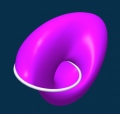The Klein bottle
 Imagine to glue the opposite edges of a rectangle so that the points at the same height on the vertical and horizontal edges are identified. You will get a doughnut, which is called a torus.
Imagine to glue the opposite edges of a rectangle so that the points at the same height on the vertical and horizontal edges are identified. You will get a doughnut, which is called a torus.
Now, imagine to glue two opposite edges as before and the remaining edges with a half twist. You will get something odd. At the first step you will get a cylinder as for the doughnut. Second, you can’t simply put together the two circles to glue them. Indeed, the orientation on the first one is opposite to that of the second one. To glue them we need to "go into" the cylinder so that the surface has self-intersections; so you will get the Klein bottle.
 The self-intersection curve is not an instance of how we obtained the surface. One can prove that it is not possible to embed the Klein bottle in three-dimensional space without self-intersections. If we want to have a mental picture of the Klein bottle, we should "not see" the self-intersection curve with the eyes of our mind. We should regard it as an "accident" due to its embedding in three-dimensional space.
The self-intersection curve is not an instance of how we obtained the surface. One can prove that it is not possible to embed the Klein bottle in three-dimensional space without self-intersections. If we want to have a mental picture of the Klein bottle, we should "not see" the self-intersection curve with the eyes of our mind. We should regard it as an "accident" due to its embedding in three-dimensional space.
We can compare it with the diagram which represents the projection of a trefoil knot on the plane. Under this projection there are some crossings. If we know that the diagram represents the projection of the knot, we know that a crossing on the projection corresponds to two points on the knot. These points belong to two different branches whose projections on the plane intersect. The same happens for the Klein bottle. The self-intersection curve corresponds to two curves on the surface, one on each sheet, which are forced to coincide on the "projection" of the bottle in three-dimensional space.
 The Klein bottle as well as the Moebius strip is a non-orientable surface. If it were labeled, and the label could move on the bottle, the label would be flipped after a full round on the "handle".
The Klein bottle as well as the Moebius strip is a non-orientable surface. If it were labeled, and the label could move on the bottle, the label would be flipped after a full round on the "handle".
The Klein bottle and the Moebius strip are "relatives". More specifically, it is possible to cut a Klein bottle in order to have two Moebius strips (or glue two Moebius strips so to get a Klein bottle).
The Moebius strip and the Klein bottle are different because the former has a boundary and the latter does not. This difference makes it possible to embed the former in three-dimensional space without self-intersections - and not the latter. There is a family of surfaces like the Klein bottle that are non-orientable and withour boundary. They can’t be embedded in three-dimensional space without self-intersections, but it is possible to do it if one makes a hole on them so to get a boundary curve.
 The first example of this family is the projective plane. It can be visualized by "seaming" a disc and a Moebius strip along their common boundary, which is a circle. It is difficult to imagine seaming a disc along the boundary of the Moebius strip when the strip is "manipulated into" this position. To help our imagination, we can deform the strip until the boundary takes the shape of a standard circle. Then we can imagine to seam a disc along the circle. Doing so, the Moebius strip takes some crossings; thus, even in this case, there are some self-intersections. In fact, this may not happen. This deformation of the Moebius strip, which turns the boundary into a "standard" circle, does not yield any self-intersections. Note, however, that if you tried to glue a disc to the circle, you would not be able to do it without intersecting the shell.
The first example of this family is the projective plane. It can be visualized by "seaming" a disc and a Moebius strip along their common boundary, which is a circle. It is difficult to imagine seaming a disc along the boundary of the Moebius strip when the strip is "manipulated into" this position. To help our imagination, we can deform the strip until the boundary takes the shape of a standard circle. Then we can imagine to seam a disc along the circle. Doing so, the Moebius strip takes some crossings; thus, even in this case, there are some self-intersections. In fact, this may not happen. This deformation of the Moebius strip, which turns the boundary into a "standard" circle, does not yield any self-intersections. Note, however, that if you tried to glue a disc to the circle, you would not be able to do it without intersecting the shell.
Therefore, also in this case it is not possible to embed the projective plane in three-dimensional space without self-intersections.
From "Matemilano, percorsi matematici in città", Ed. Springer